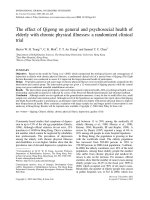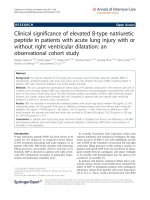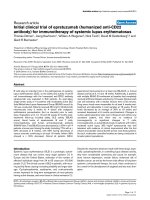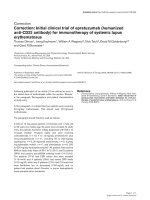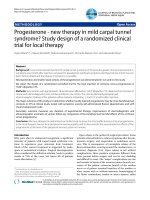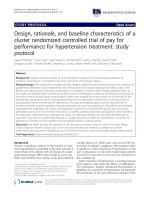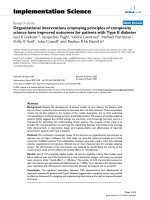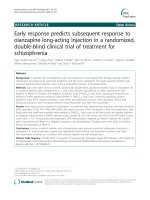A parallel-group randomized clinical trial of individually tailored, multidisciplinary, palliative rehabilitation for patients with newly diagnosed advanced cancer: The Pal-Rehab study
Bạn đang xem bản rút gọn của tài liệu. Xem và tải ngay bản đầy đủ của tài liệu tại đây (660.3 KB, 10 trang )
Nottelmann et al. BMC Cancer (2017) 17:560
DOI 10.1186/s12885-017-3558-0
STUDY PROTOCOL
Open Access
A parallel-group randomized clinical trial of
individually tailored, multidisciplinary,
palliative rehabilitation for patients with
newly diagnosed advanced cancer: the
Pal-Rehab study protocol
Lise Nottelmann1,5* , Mogens Groenvold2,3, Tove Bahn Vejlgaard1, Morten Aagaard Petersen2
and Lars Henrik Jensen4,5
Abstract
Background: The effect of early palliative care and rehabilitation on the quality of life of patients with advanced
cancer has been only sparsely described and needs further investigation. In the present trial we combine elements
of early, specialized palliative care with cancer rehabilitation in a 12-week individually tailored, palliative rehabilitation
program initiated shortly after a diagnosis of advanced cancer.
Methods: This single center, randomized, controlled trial will include 300 patients with newly diagnosed advanced
cancer recruited from the Department of Oncology, Vejle Hospital. The patients are randomized to a specialized
palliative rehabilitation intervention integrated in standard oncology care or to standard oncology care alone. The
intervention consists of a multidisciplinary group program, individual consultations, or a combination of both. At baseline
and after six and 12 weeks the patients will be asked to fill out questionnaires on symptoms, quality of life, and
symptoms of depression and anxiety. Among the symptoms and problems assessed, patients are asked to indicate the
problem they need help with to the largest extent. The effect of the intervention on this problem is the primary outcome
measure of the study. Secondary outcome measures include survival and economic consequences.
Discussion: To our knowledge the Pal-Rehab study is the first randomized, controlled, phase III trial to evaluate individually
tailored, palliative rehabilitation in standard oncology care initiated shortly after an advanced cancer diagnosis.
The study will contribute with evidence on the effectiveness of implementing early palliative care in standard oncology
treatment and hopefully offer new knowledge and future directions as to the content of palliative rehabilitation programs.
Trial Registration: Clinicaltrials.gov Identifier: NCT02332317, registered retrospectively on December 30, 2014. One study
participant had been enrolled at the time.
Keywords: Palliative care, Early integrated care, Rehabilitation, Supportive care, Advanced cancer, Quality of life research,
Patient involvement, Randomized clinical trial, Cost-effectiveness, Study protocol
* Correspondence:
1
Department of Oncology, Palliative Team, Vejle Hospital, Beriderbakken 4,
7100 Vejle, Denmark
5
Institute of Regional Health Research, University of Southern Denmark,
Odense, Denmark
Full list of author information is available at the end of the article
© The Author(s). 2017 Open Access This article is distributed under the terms of the Creative Commons Attribution 4.0
International License ( which permits unrestricted use, distribution, and
reproduction in any medium, provided you give appropriate credit to the original author(s) and the source, provide a link to
the Creative Commons license, and indicate if changes were made. The Creative Commons Public Domain Dedication waiver
( applies to the data made available in this article, unless otherwise stated.
Nottelmann et al. BMC Cancer (2017) 17:560
Background
Early integrated palliative care
Studies have shown that cancer patients have unmet
palliative needs (e.g. physical, social, emotional, and cognitive challenges related to living with cancer) [1].
Palliative care is applicable early in the course of illness
and in conjunction with other therapies [2] but is often
thought to address “end-of-life”-needs only; perhaps especially in the eyes of professionals involved in oncology,
who often play the role of referring the patients to specialized palliative care when all other treatment options are
exhausted [3]. Many patients and caregivers associate palliative care with hopelessness and giving up [4]. As a result
many patients are not referred to specialized palliative
care until late in the disease trajectory [5].
According to The World Health Organization (WHO,
2002) palliative care should not only be considered for
the dying but for all patients and families living with a
life threatening illness [2] and thus be an integrated part
of the treatment at an early stage of the disease. This
approach is known as early integrated palliative care.
The recommendations are very general and lack specifications about the timing and content of the early, integrated palliative care intervention.
The American Society of Clinical Oncology released a
provisional clinical opinion in 2012 about the integration
of palliative care into standard oncology care [6] based on
seven randomized clinical trials. The conclusion in this expert opinion was that, while evidence clarifying optimal
delivery of palliative care to improve patient outcomes is
evolving[…] strategies to optimize concurrent palliative
care and standard oncology care, with evaluation of its impact on important patient and caregiver outcomes (e.g.
quality of life, survival, health care services utilization, and
costs and on society, should be an area of intense research.
This provisional clinical opinion has just been updated
reflecting the change in evidence since the previous
guideline [7]. The Expert Panel still concludes that more
research is needed, especially with inclusion of patients
with advanced cancer in early-phase clinical trials.
Several studies have investigated the integration of specialized palliative care into clinical oncology for patients
with advanced cancer with promising results. The studies
differ, however, in outcome measures, study participants,
and timing and contents of the early palliative intervention.
A Canadian study published in 2009 [8] was the first to
test the hypothesis that patients with advanced cancer
who were offered specialized palliative care shortly after
the diagnosis in conjunction with standard care would be
more informed and participate more actively in their treatment plan and care. The hypothesis was that this would
lead to better quality of life (QoL), better symptom control, lower depression rate and lower health expenses
compared with the patients who received standard
Page 2 of 10
treatment. A total of 322 patients with newly diagnosed
advanced breast, lung, gastrointestinal or genitourinary
cancer were randomized. The intervention was a telephone based educational and supportive program led by
specialized nurses. The weekly sessions were designed to
empower patients to articulate palliative and end-of-life
needs to their oncologist. The results showed significantly
better self-reported QoL and lower depression rates in the
intervention group compared to the control group,
whereas no improvement in symptom control or decrease
in health expenses was shown.
In an American single center study published in
2010–12 [9–11], 151 patients with newly diagnosed
metastatic non-small cell lung cancer were randomized
to standard care or standard care plus a palliative care
intervention. The intervention was at least one monthly
consultation with a specialized palliative care physician
and nurse. The primary outcome measure was QoL
12 weeks after randomization. Other outcome measures
were anxiety and depression, and health care expenses.
The study was not designed to show differences in survival, but the analysis was made post hoc. The result of
the study was significantly higher self-reported QoL of
the patients who had received the palliative intervention.
The intervention group also showed significantly fewer
symptoms of anxiety and depression after 12 weeks and
even a significantly longer mean survival of 11.6 months
vs 8.9 months despite less aggressive active treatment in
the intervention group.
The question of timing was evaluated in a large study
of early versus delayed initiation of a palliative care
intervention published in 2015 [12]. Patients (N = 207)
with advanced cancer were randomly assigned to receive
an in-person specialized palliative care consultation,
structured telehealth nurse coaching sessions (once per
week for six sessions), and monthly follow-up either
early after enrollment or 3 months later. The outcome
measures were group differences in QoL, symptom impact, mood, 1-year survival, and resource use. The study
showed that the patient-reported outcomes and resource
use of early entry participants were not statistically different from that of the late entry participants; however,
their 1-year survival was significantly improved compared to those who began 3 months after enrollment.
Other studies of early, integrated, specialized palliative
care have pointed to improved QoL [13], better patient
and caregiver satisfaction with care, and a high level of
satisfaction with the integrated model amongst oncologists due to patient satisfaction, reduction of symptom
burden, and time saved in the clinic [14, 15].
Rehabilitation of patients with advanced cancer
The average survival time of patients with advanced cancer, calculated from the date of diagnosis until death, is
Nottelmann et al. BMC Cancer (2017) 17:560
improving [16], which makes the discussion of rehabilitation of this group of patients increasingly relevant.
Specialized palliative care is a multidisciplinary approach aiming at relieving suffering in all its dimensions
throughout the course of life-threatening disease and for
everyone closely affected by the disease [2]. Rehabilitation aims at improving and maintaining physical, mental,
social and intellectual performance levels and preventing
loss of functions related to activities of daily living
(ADL) with the purpose of supporting independence and
self-management [16].
The overlap between specialized palliative care and
rehabilitation becomes clear when assessing the resources and needs of the individual patient and caregiver,
especially early in the disease trajectory. Specialized palliative care and rehabilitation involve many of the same
health professionals and can be combined in an ambulatory setting [16].
In Great Britain the “Palliative Day Care Centers/ Services” have existed for decades combining specialized
palliative care and rehabilitation. The physical frame is
often a hospice. Group activities play a pivotal role with
a combination of group discussions of issues related to
living with cancer and physical exercise. A review of 15
quantitative and qualitative studies about” Palliative Day
Care Centers/Services” conclude that they provide a high
degree of patient and caregiver satisfaction and that the
possibility of forming relations with the staff and other
patients is of great importance [17]. Whether the patients experienced better symptom control or better
health related QoL from participating in the services
was not clear.
A phase II study from Norway published in 2006
tested the effect of an individually tailored twice-a-week
6-week physical exercise program on physical performance and QoL in patients with incurable cancer and a
life expectancy of less than one year [18]. The conclusion was that the exercise program was not only feasible;
it also significantly improved the physical and emotional
functioning of the patients and reduced fatigue. However, the study population was quite small and did not
include a control group.
An American study published in 2015 tested the effect
of a multidisciplinary QoL-directed intervention on
patients’ adherence to the planned chemoradiation treatment [19]. A cohort of 61 patients with advanced localized gastrointestinal cancer was formed by pooling the
results of two randomized, controlled trials using the
same intervention. Twenty-nine patients were randomized to participate in sessions of exercise, education, and
relaxation two or three times a week for six or eight
weeks, and 32 patients received standard medical care.
The study found a significantly higher proportion of patients completing the “as planned” cancer treatment and
Page 3 of 10
significantly fewer requiring hospitalization in the intervention group compared to the control group, and the
results were still statistically and clinically significant
when the analyses were completed for the subgroup who
received neoadjuvant chemoradiation treatment.
Aim of this study
The overall experience with early, integrated, specialized
palliative care and rehabilitation of advanced cancer patients is positive, but the evidence is still sparse and
more research is required.
The Pal-Rehab study combines elements of early, integrated, specialized palliative care with elements of rehabilitation in an individually tailored intervention in
patients with advanced cancer.
The aim of this study is to elucidate whether a 12-week
individually tailored, palliative rehabilitation program initiated shortly after an advanced cancer diagnosis reduces
physical and emotional symptoms/problems and improves
QoL. The patient chooses the main symptom/problem to
be focused on. Impact on survival and economic consequences measured as health service utilization will also
be evaluated.
Methods/design
Study design
The study is a phase III, controlled, randomized trial
with 300 patients allocated 1:1 to an intervention or a
control group at the Department of Oncology, Vejle
Hospital. The department offers treatment to adult patients with pulmonary, breast, prostate, colorectal, anal
and biliary tract cancer, as well as cancers of the female
reproductive organs. On a yearly basis there are around
57,000 outpatient visits and 23,000 radiotherapy fractions and 9300 chemotherapy treatments are administered. Geographically, the patients have up to 1½ hours
of transport time by car to the hospital.
Newly diagnosed advanced cancer patients initiating
oncologic treatment who consent to participate will be
randomized to an individually tailored palliative rehabilitation program alongside their standard oncology care
(disease specific treatment) or to standard oncology care
alone. Study measures and timepoints can be seen in Fig. 1.
Study participants
Three hundred patients will be recruited according to
the selection criteria (Table 1).
Patients are eligible if the first choice of treatment is
systemic and complete surgical removal of the malignant
tissue is either ruled out or depends on the success of
the systemic treatment. Patients with advanced prostate
cancer are often seen at other departments than the
Oncology Department following the diagnosis, but they
Nottelmann et al. BMC Cancer (2017) 17:560
Page 4 of 10
Fig. 1 Study outline
are considered eligible when they are referred to systemic treatment at the Oncology Department for the
first time.
Enrollment procedure and baseline data collection
Eligible patients are informed about the project by a
doctor or nurse in the outpatient clinic.
Table 1 Selection criteria
Inclusion criteria
1. First-time non-resectable cancer diagnosed less than 8 weeks
before enrollment. Patients with prostatic cancer are eligible, if
referred to systemic oncologic treatment for the first time less than
8 weeks before enrollment (e.g. due to failure of anti-hormone
treatment).
2. Eligible for systemic oncologic treatment at Vejle Hospital and
accepts treatment.
3. ≥ 18 years of age.
4. Reads and understands Danish
5. Written and orally informed consent.
Exclusion criteria
1. Other contact with a specialized palliative care unit within 1 year of
enrollment.
2. Inability to comply with the protocol due to cognitive or other
impairment.
Patients who have signed the informed consent form
are asked to complete a baseline questionnaire. Baseline
characteristics of the patient (WHO performance status,
diagnosis, age, gender, time of primary diagnosis, cancer
stage, marital status, and educational background) are
registered. Randomization is subsequently performed by
the clinical trial unit using a randomization list from
randomizer.org [20]. Patients are randomized 1:1 to the
intervention or control group with no further stratification used during randomization. The randomization list
is blinded from anyone involved in informing potential
study participants.
If a patient does not wish to participate, the reason is
noted, if possible, and the following characteristics are
registered anonymously; diagnosis, age, gender, WHO
performance status, cancer stage, marital status and educational background.
The intervention
The intervention combines elements of specialized palliative care with rehabilitation of cancer patients and is a
multidisciplinary assessment of symptoms/problems,
Nottelmann et al. BMC Cancer (2017) 17:560
Page 5 of 10
QoL, and potential barriers to activities of daily living
(ADL) in patients receiving standard oncologic treatment.
The intervention is tailored to the individual patient
and since rehabilitation is best described as a process
containing specific actions [21], the bundle of actions is
investigated rather than single components.
As suggested by Wade [22] the intervention is categorized into five main descriptors; the target population,
goals of the intervention, activity or process, resources
used, and context (Table 2).
Within one week after randomization patients allocated to the intervention are seen in the outpatient clinic
by a physician and nurse specialized in palliative care.
The themes covered in the first consultation are shown
in Table 3.
At the end of the first consultation a plan for the following 12 weeks is made together with the patient and
caregivers based on their needs and wishes. The intervention provided reflects the offers of the specialized
palliative care team to outpatients, i.e. individual consultations at the hospital, telephone consultations, and/or a
palliative rehabilitation group program consisting of
weekly group discussions followed by one hour of physical
Table 3 Content of the first intervention consultation
• Gaps between wishes for ADL and the patient’s current situation
• Prognostic awareness
• Problems with the ”patient/caregiver-role”
• Sleeping disorders
• Tiredness and fatigue
• Problems with memory or concentration
• Lack of appetite, weight loss
• Pain, respiratory problems, constipation, and other frequent symptoms
• Anxiety, worry, sadness
• Feeling of meaninglessness in the current situation
• Coping mechanisms of patients and caregivers and potential differences
• Problems of a socio-economic character or family issues
• Problems concerning work life
exercise, also in groups. If the group program is relevant
to the patient, this will be the main intervention. Caregivers are welcome in the group discussions dealing with a
new theme every week for 12 weeks. A dedicated, specialized palliative care nurse guides the group, and other
Table 2 Description of the individually tailored palliative rehabilitation intervention
Target population
Patients with newly diagnosed non-resectable cancer
Goals of the intervention
Immediate goals
• To help patients and caregivers with symptoms/problems identified through questionnaires
and a specialized palliative care consultation
• To improve overall QoL through symptom control, improvement of physical performance
level, and better understanding of the disease and related symptoms
Distal/general goals
• To improve survival and reduce health service utilization by early recognition of symptoms
and problems, improvement of physical performance level and ability to complete “as
planned” cancer treatment, and support of patient and caregiver empowerment in future
treatment decisions
Activity/process
• Individual consultations
• Group educational program for patients and caregivers
• Group physical exercise program for patients
• Contact to other health departments, the primary sector, local municipality and employer,
if relevant and the patient consents
Resources
• Human resources
A specialized palliative care team consisting of physicians, nurses, physiotherapists,
psychologists, a dietician, an occupational therapist, a social worker, and a hospital
chaplain
• Physical resources
A consultation room, a group room, and a group exercise room.
• Time resources
The initial specialized palliative care consultation has a duration of approximately one
hour plus on average 15 min for the multidisciplinary team conference. The follow-up
consultation with a specialized palliative care nurse takes about 30–45 min
The group educational program and physical exercise program lasts two and a half
hours once a week for twelve weeks.
Additional resources are based on individual needs and wishes of patients and caregivers
and will be assessed retrospectively
Context
• Scientific context
Investigation of early, integrated palliative care and rehabilitation for advanced cancer
patients
• Organizational structures
The specialized palliative care team is organized under the Department of Oncology
Nottelmann et al. BMC Cancer (2017) 17:560
health professionals involved in the group program join in
depending on the subject. The headlines of the group discussions reflect the themes covered in the first consultation (Table 3) and patients and caregivers receive an
overview, when they join the group. Weekly attendance is
not mandatory. A patient participating in the group physical exercise program meets with a specialized palliative
care physiotherapist beforehand and an individual exercise
program is tailored following a series of tests. When the
12-week program has been completed, the patient is examined by the same physiotherapist and receives tailored
advice on future physical activity.
During the 12-week group program the patients and
caregivers will have supplementary individual consultations if needed, together or separately. At the end of the
program they are offered a final evaluation with the same
physician and nurse they met at the first consultation.
Caregivers participating in the group program are encouraged to share their thoughts and experiences with
each other in a separate room while the patients do the
physical training.
If the patient/caregiver prefers or is better suited for
individual consultations instead of the group program,
this will be accommodated.
If no further intervention is initiated after the first
consultation, the patient and caregivers are provided
with contact details and may approach the palliative
team any time during the next 12 weeks without a new
referral.
All patients and caregivers in the intervention group
are discussed at least once at a multidisciplinary team
conference. A midway follow-up consultation with a
specialized palliative care nurse is held six to seven
weeks after randomization.
In order to describe the intervention in detail a “contact sheet” covering all possible elements of the intervention is used for prospective registration. Members of
the specialized palliative care team fill in the sheet after
each contact with a patient or caregiver. Medical records
are also kept for further details.
The control group
The control group receives standard care at the Department of Oncology. In addition to anticancer treatment
all patients have access to a number of paramedical services available through referral (Table 4). These services
are not open for caregivers.
Outcome measures
Study objectives
The primary objective of the study is to assess the
impact of the intervention on the symptom/problem prioritized by the patient. Secondary objectives are 1) to assess the impact on the symptoms/problems represented
Page 6 of 10
Table 4 Standard hospital based paramedical care
Nutritional support
• All cancer patients are screened for weight loss
at the beginning of each treatment. In case of
significant weight loss the patient is referred to
a dietician
Physical support
• The patient can be referred to the hospital
physiotherapist. The main reason is significant
lymphedema
• In cooperation between clinical oncology nurses
and hospital physiotherapists patients having a
high performance level are offered an extensive
group based training program 4 times a week
for 6 weeks
Phsycosocial support • The outpatient clinic employs psychologists and
social workers, and the hospital has a priest. The
mean waiting time for a patient referred to a
psychologist is currently 3 weeks
in the questionnaires, including QoL and symptoms of
depression and anxiety, 2) to assess the impact on survival, and 3) to analyze economic consequences measured as health service utilization from enrollment until
three months after final data collection.
Measurement instruments
All participants complete a questionnaire at baseline and
six and 12 weeks after randomization. The questionnaire
consists of EORTC QLQ-C30, which is a validated and
widely used questionnaire for assessing symptoms and
QoL in cancer patients [23], and Hospital Anxiety and
Depression Scale (HADS), which is also validated and
often used for screening and assessment of symptoms of
anxiety and depression in palliative care, oncology, and
other fields of research [24].
The EORTC QLQ-C30 consists of 30 items in 15
scales. In the present study additional items measuring
role functioning, cognitive functioning, social functioning, dyspnea, pain, fatigue, insomnia, appetite loss, nausea/vomiting and constipation were added to the
questionnaire to expand these scales to at least four
items in each scale. The extra items were taken from the
item banks developed for computer-adaptive testing of
the EORTC QLQ-C30 dimensions [25–28]. The international clinical validation of the item banks is ongoing.
At baseline the patient prioritizes one “primary problem” from a list of 12 categories of “primary problems”
corresponding to 12 of the 15 scales of EORTC QLQC30, or “none of the above” (Table 5). At six and 12weeks follow-up the patient is asked whether he/she has
received help with the “primary problem” (yes/no) and if
yes, whether the help was “insufficient”, “partly sufficient” or “sufficient”.
The primary outcome measure is the difference between the intervention and control groups in the change
from baseline to the weighted average at the six and 12week follow-up measured as area under the curve
Nottelmann et al. BMC Cancer (2017) 17:560
Table 5 List of possible “primary problems” the study
participants to choose from
“Primary problem”
Corresponding outcome measure
in EORTC QLQ-C30
Limitations in physical functioning
Physical function scale
Limitations in work and daily
activities
Role function scale
Limitations in social life
Social function scale
Problems with memory and
concentration
Cognitive function scale
Emotional problems (worry, irritation, Emotional function scale
depression, tension)
Fatigue (tiredness and weakness)
Fatigue scale
Pain
Pain scale
Breathlessness
Dyspnea item
Loss of appetite
Loss of appetite item
Nausea
Nausea and vomiting scale
Constipation
Constipation scale
Trouble sleeping
Insomnia item
None of the above
(AUC) of the EORTC QLQ-C30 scale/category chosen
by the patient (e.g., if pain was designated as ‘primary
problem’, the primary outcome is based on the EORTC
QLQ-C30 pain scale). If a patient has ticked the box
“none of the above” and hence has not chosen any of
the 12 scales/categories, the primary outcome measure
for this patient will be change in health related QoL corresponding to the “Global health status/QoL”-scale in
EORTC QLQ-C30. This way of devising and analyzing
an individualized trial outcome has previously been
motivated and elaborated, although in the previous study
the patients did not select the outcome measure
[29, 30]. The expanded EORTC scales (see above) will be
used in the primary outcome; the traditional EORTC
QLQ-C30 scales will be used in a secondary analysis.
Statistical analysis and sample size calculation
Sample size estimation
Data from other studies using EORTC QLQ-C30 suggest
a standard deviation of less than 25 for a difference between the repeated measurements, and a group difference of 10 for clinical relevance [31].
With a risk of type I error of 0.05 and type II error of
0.10, 133 patients are required in each arm. In order to
allow for a dropout rate of approximately 10% each arm
will enroll 150 patients for a total of 300 patients.
Page 7 of 10
primary analysis will be based on the intention-to-treat
principle. If the proportion of lacking answers is higher
than 5%, we will use multiple imputations in the primary
analysis with the following variables: age, gender, diagnosis, cancer stage, and WHO performance score. The
questionnaire data will be transformed according to their
respective scoring manuals [32, 24].
Multiple regressions will be applied, since despite the
randomized design there may be imbalance between the
two arms. We will adjust for “the primary problem” and
WHO performance score.
Wilcoxon and Chi2 will be used to investigate whether
there are differences between the two groups in relation
to the following variables that may be of prognostic importance: gender, age, cancer stage, primary diagnosis,
marital status, and educational background. If a significant group difference is found, the respective variable
will be included in a sensitivity analysis.
In the analyses we combine the data from the three
questionnaires by constructing an AUC using a weighted
average of the change from baseline to the 6 and 12week follow-up. A model for longitudinal data and repeated measurements in the multivariate analysis is
applied as a subsequent sensitivity analysis.
Since the primary outcome measure “the primary
problem” consists of 13 possible choices, we will also
perform separate analyses of patients with the same primary problem.
Survival
Survival will be described by Kaplan-Meier plots. Patients still alive three months after final data collection
will be censored as of that date. A Cox regression model
will also be applied controlling for the same variables as
in the questionnaire data analysis.
Economic consequences
Data on the number and length of hospital admissions
and treatments, visits to outpatient clinics, emergency
rooms, and general practitioners are applied in the
evaluation of economic consequences of the intervention. The calculation includes the period from enrolment
until three months after final data collection. The data
are available from the Danish National Patient Registry
[33] and the costs of the different services are obtainable
through the Danish Health Authority.
Multivariate analysis is used to compare the two
groups controlling for the same variables as in the questionnaire data analysis.
Plan of analysis
Questionnaire data
Other statistical and methodological considerations
Analyses will be made using the statistical package
STATA, latest version (StataCorp, Texas, USA). The
A certain degree of cross over and loss to follow-up is
expected in this study and will be registered.
Nottelmann et al. BMC Cancer (2017) 17:560
The baseline characteristics of responders and nonresponders will be compared to elucidate any differences. Likewise, the difference in baseline characteristics
of patients who were invited to participate but declined
and the study participants will be investigated.
Blinding of study participants and health professionals is
not possible. However, the primary data analysis will be
conducted in a blinded manner using coded numbers not
referring to allocation or identifying patient characteristics.
Page 8 of 10
To our knowledge this is the first time an individually
tailored palliative rehabilitation program including a
group offer is being evaluated in a randomized controlled setting where the patient group is not selected by
cancer type or performance level. Also, this study seems
to be the first to assess whether or not early palliative
care is helpful in relation to the primary problem specified by the patient.
Reflections on the intervention of the study
Patient and caregiver involvement in the study
Before recruitment was initiated the main intervention of
the study (the group program) went through a pilot period
where alterations were made based on feedback by patients and caregivers to ensure feasibility and relevance.
The intervention is individually tailored during the 12week study period. Only the initial and midway consultations are mandatory, which leaves room for a great
deal of patient and caregiver involvement in the design
of the intervention. The individual primary outcome is
also chosen by the patient.
The trial is conducted in close collaboration with the
Patient and Relatives Council at Vejle Hospital. The
protocol was discussed with and finally approved by the
Council, which also has a consulting role during the
research process. Dissemination of the study result will
also take place in collaboration with the Patient and Relatives Council.
Ethical considerations
In the study period no effort will be made to prevent patients in the control arm from being referred to specialized palliative care according to the referral criteria of
the specialized palliative care team. The Helsinki II declaration is followed unconditionally.
Time plan
The study is actively recruiting and 68% of the intended
study population has been enrolled so far. The analyses
are expected to be finalized in 2018.
Discussion
The Pal-Rehab study is a randomized, controlled, single
center, phase III trial evaluating palliative rehabilitation as
a supplement to standard oncology care in the hospital
setting for patients with newly diagnosed advanced cancer.
After baseline assessment the patients will be randomized
to either the intervention group receiving palliative rehabilitation involving systematic and tailored elements or
to the control group receiving standard care alone.
Follow-up measurements allow the detection of group
differences in symptom control, mood and QoL. Health
service utilization and survival will also be investigated.
We want to reach the patients and caregivers soon after
time of diagnosis in order to focus on early recognition
of symptoms and problems affecting QoL and on empowerment of the patients and caregivers with tailored
advice by health professionals.
Patients with advanced cancer have many visits to the
hospital, especially during standard oncologic treatment.
The rehabilitation program takes place at the hospital
where the patient is undergoing oncology care. The hospital
setting ensures close collaboration between the specialized
palliative care team and other healthcare professionals.
Everybody involved in the treatment has access to the same
patient record. For instance the physiotherapist can access
the patient’s diagnostic imaging reports which is helpful in
the individual counselling, e.g. about restrictions due to
bone metastases.
The group program is the main intervention. In
addition to saving time and resources a group intervention enables patients and caregivers to meet with other
people in a similar situation.
With the eligibility criteria of this study the traditional
distinction between treatment with palliative and curative intent is avoided. Instead, the target group is defined as patients (and caregivers) living with advanced
cancer at the time of initiating oncologic treatment. This
definition seems relevant as to the future selection of patients for palliative rehabilitation based on the findings
of this study.
Potential weaknesses and strengths of the study
It is a general problem that the voluntariness of research
participation and potential gate keeping may lead to the
selection of the most resourceful patients, who may not
be the ones most in need of palliative support [34]. This
is also true for the present study. Furthermore, patients
with severe cognitive impairments are excluded from
participation for ethical reasons. The prognostic factors
of all patients invited to participate will be registered
along with the reasons stated by patients who do not
wish to participate. In this way we hope to be able to
discuss our findings in the light of the characteristics of
the group we have investigated and knowledge about the
patients not included.
Nottelmann et al. BMC Cancer (2017) 17:560
The complexity of rehabilitation as a process poses
great challenges in research and it is difficult to separate
the specific features of an intervention from non-specific
aspects that nonetheless may have powerful effects [21].
For instance it cannot be ruled out that preexisting beliefs about the effectiveness of the intervention plays a
role when patients report their outcome. We have
chosen two approaches to this methodological problem;
firstly, patients are informed in a neutral manner, where
few details about the content of the intervention are revealed before randomization. Secondly, patients are asked
to choose a “primary problem” before randomization and
are asked at follow-up, whether or not they have been
helped with this problem. However, they are not informed
that the “primary problem” they have chosen correlates to
a scale in the EORTC QLQ-C30 questionnaire and they
do not have their baseline questionnaire for comparison
when answering the follow-up questionnaires. The primary outcome measurements are based on the scores in
EORTC QLQ-C30.
Where the word “rehabilitation” may raise positive expectations, “palliative care” sometimes carries a stigma
of death or dying, which will expectedly be a challenge
when recruiting patients with newly diagnosed advanced
cancer. As part of the oral information the patient and
caregivers are specifically asked, if they have any experience with “palliative care” and the meaning of the
word. If relevant, they are informed that the aim of the
intervention is not “end-of-life support”. Patients are
also informed that they can participate in the study regardless of whether they initially feel a need for an intervention or not.
Pal-Rehab is a single center study, which may limit
generalization of the results. On the other hand the
study only includes healthcare professionals conventionally present at any hospital offering systemic cancer
treatment in our country. The physical requirements are
one group room and physical exercise facilities. We
therefore believe the intervention is transmissible to
other departments of oncology.
This study does not specifically evaluate the impact on
the caregivers although the intervention does aim to
cover the needs of the caregivers if invited by the patient.
When evaluating economic consequences, the patient’s
utilization of health services is calculated, but expenses
such as additional transportation and time off from work
in connection with study participation are not considered.
There may be a certain amount of cross-over, since the
group offer of palliative rehabilitation for people living
with cancer is open through referral outside the protocol.
However, according to our experience from the first two
years of practice, patients are not referred until rather late
in their disease trajectory and substantially later than the
patients we are recruiting for this trial.
Page 9 of 10
Conclusion
The Pal-Rehab study is a randomized controlled trial investigating whether an individually tailored, palliative rehabilitation program initiated shortly after diagnosis of
advanced cancer improves the QoL of the patients. To
our knowledge this has never been done before. The results will contribute to the evidence on early palliative
care in standard oncology treatment and hopefully offer
new knowledge and future directions about palliative rehabilitation programs.
Abbreviations
ADL: Activities of Daily Living; AUC: Area Under the Curve; EORTC QLQC30: European Organisation for Research and Treatment of Cancer Quality of
Life Core Questionnaire, version 3; HADS: Hospital Anxiety and Depression
Scale; QoL: Quality of Life; WHO: The World Health Organization
Acknowledgements
The authors wish to thank all financial benefactors mentioned under “Funding”.
We thank the patients and caregivers participating in the study, and the Patient
and Relatives Council of Vejle Hospital for valuable input and inspiring
discussions. We thank the employees at the Department of Oncology, the
Specialized Palliative Care Team, and the Clinical Trial Unit for their contribution
to the study. We thank Karin Larsen for linguistic editing of the manuscript.
Funding
The Danish Cancer Society, the Research Council of Lillebaelt Hospital, The
Andreas and Grethe Gullev Hansens’ Foundation, and The Family Hede
Nielsens’ Foundation support this research financially. None of the above
have been involved in the design of the study or the writing of this manuscript.
Nor will they be involved in the collection, analysis, or interpretation of data
from the study.
Availability of data and materials
Data collection is not complete. The trial is approved by The Danish Data
Protection Agency.
Authors’ contributions
LN conducts the trial as described in the protocol and drafted this manuscript.
MG and TV conceived the study and its design and have revised the manuscript
with substantial contributions. MAP participated in the design of the analyses
plan and contributed to the draft of the manuscript. LHJ participated in the
design and coordination of the study and helped to draft the manuscript. All
authors read and approved the final manuscript.
Authors’ information
Authors LN and LHJ are affiliated with OPEN, Odense Patient data Explorative
Network, Odense University Hospital, Odense, Denmark.
Tove Bahn Vejlgaard is former Head of the PalliativeTeam, Vejle (retired).
Ethics approval and consent to participate
All study participants are enrolled following verbal and written informed
consent. The study protocol including the written material intended for
potential study participants and the informed content sheet was approved
by The Regional Committees on Health Research Ethics for Southern
Denmark on April 2nd, 2014 (Project ID S-20140038).
Consent for publication
Not applicable.
Competing interests
The authors declare that they have no competing interests.
Publisher’s Note
Springer Nature remains neutral with regard to jurisdictional claims in
published maps and institutional affiliations.
Nottelmann et al. BMC Cancer (2017) 17:560
Author details
1
Department of Oncology, Palliative Team, Vejle Hospital, Beriderbakken 4,
7100 Vejle, Denmark. 2Research Unit, Department of Palliative Medicine,
Bispebjerg Hospital, Copenhagen University Hospital, Copenhagen, Denmark.
3
Department of Public Health, University of Copenhagen, Copenhagen,
Denmark. 4Danish Colorectal Cancer Center South, Vejle Hospital,
Beriderbakken 4, Vejle, Denmark. 5Institute of Regional Health Research,
University of Southern Denmark, Odense, Denmark.
Received: 30 January 2017 Accepted: 16 August 2017
References
1. Johnsen AT, Petersen MA, Pedersen L, Groenvold M. Symptoms and problems
in a nationally representative sample of advanced cancer patients. Palliat Med.
2009;23:491–501.
2. World Health Organization | WHO Definition of Palliative Care. http://www.
who.int/cancer/palliative/definition/en/ (2012). Accessed 23 Aug 2016.
3. Horlait M, Chambaere K, Pardon K, Deliens L, Van Belle S. What are the
barriers faced by medical oncologists in initiating discussion of palliative
care? A qualitative study in Flanders, Belgium. Support Care Cancer.
2016;24:3873–81.
4. Zimmermann C, Swami N, Krzyzanowska M, Leighl N, Rydall A, Rodin G, et
al. Perceptions of palliative care among patients with advanced cancer and
their caregivers. CMAJ. 2016;188(10):E217–27.
5. Danish Palliative Database Annual Report (2015). />573/%C3%85rsrapport-fra-dansk-palliativ-database
6. Smith TJ, Temin S, Alesi ER, Abernethy AP, Balboni TA, Basch EM, et al.
American Society of Clinical Oncology Provisional Clinical Opinion: The
Integration of Palliative Care Into Standard Oncology Care. J Clin Oncol Am
Soc Clin Oncol. 2012;30:880–7.
7. Ferrell BR, Temel JS, Temin S, Alesi ER, Balboni TA, Basch EM, et al. Integration
of Palliative Care Into Standard Oncology Care: American Society of Clinical
Oncology Clinical Practice Guideline Update. J Clin Oncol. 2017;35:96–112.
8. Bakitas M, Lyons KD, Hegel MT, Balan S, Brokaw FC, Seville J, et al. Effects of
a palliative care intervention on clinical outcomes in patients with advanced
cancer: the Project ENABLE II randomized controlled trial. JAMA. 2009;302:741–9.
9. Temel JS, Greer JA, Muzikansky A, Gallagher ER, Admane S, Jackson VA, et al.
Early palliative care for patients with metastatic non-small-cell lung cancer.
N Engl J Med. 2010;363:733–42.
10. Greer JA, Pirl WF, Jackson VA, Muzikansky A, Lennes IT, Heist RS, et al. Effect
of early palliative care on chemotherapy use and end-of-life care in patients
with metastatic non-small-cell lung cancer. J Clin Oncol. 2012;30:394–400.
11. Pirl WF, Greer JA, Traeger L, Jackson V, Lennes IT, Gallagher ER, et al. Depression
and survival in metastatic non-small-cell lung cancer: effects of early palliative
care. J Clin Oncol. 2012;30:1310–5.
12. Bakitas MA, Tosteson TD, Li Z, Lyons KD, Hull JG, Li Z, et al. Early Versus Delayed
Initiation of Concurrent Palliative Oncology Care: Patient Outcomes in the
ENABLE III Randomized Controlled Trial. J Clin Oncol. 2015;33:1438–45.
13. Zimmermann C, Swami N, Krzyzanowska M, Hannon B, Leighl N, Oza A, et
al. Early palliative care for patients with advanced cancer: a clusterrandomised controlled trial. Lancet. 2014;383:1721–30.
14. Follwell M, Burman D, Le LW, Wakimoto K, Seccareccia D, Bryson J, et al.
Phase II study of an outpatient palliative care intervention in patients with
metastatic cancer. J Clin Oncol. 2009;27:206–13.
15. Muir JC, Daly F, Davis MS, Weinberg R, Heintz JS, Paivanas TA, et al. Integrating
palliative care into the outpatient, private practice oncology setting. J Pain
Symptom Manag. 2010;40:126–35.
16. Danish Health Authority - Cancer Rehabilitation and Palliative Care Programme
(2012). />17. Davies E, Higginson IJ. Systematic review of specialist palliative day-care for
adults with cancer. Support Care Cancer. 2005;13:607–27.
18. Oldervoll LM, Loge JH, Paltiel H, Asp MB, Vidvei U, Wiken AN, et al. The effect of
a physical exercise program in palliative care: A phase II study. J Pain Symptom
Manag. 2006;31:421–30.
19. Cheville AL, Alberts SR, Rummans TA, Basford JR, Lapid MI, Sloan JA, et al.
Improving Adherence to Cancer Treatment by Addressing Quality of Life in
Patients With Advanced Gastrointestinal Cancers. J Pain Symptom Manag.
2015;50:321–7.
Page 10 of 10
20. Urbaniak, G. C.; & Plous S. (2013) Research Randomizer (Version 4.0) [Computer
software]. Retrieved on June 22; 2013. Res Randomizer. Available from: https://
www.randomizer.org/
21. Wade DT, Smeets RJEM, Verbunt JA. Research in rehabilitation medicine:
methodological challenges. J Clin Epidemiol. 2010;63:699–704.
22. Wade DT. Describing rehabilitation interventions. Clin Rehabil. 2005;19:811–8.
23. Groenvold M, Klee MC, Sprangers MA, Aaronson NK. Validation of the
EORTC QLQ-C30 quality of life questionnaire through combined qualitative
and quantitative assessment of patient-observer agreement. J Clin Epidemiol.
1997;50:441–50.
24. Zigmond AS, Snaith RP. The hospital anxiety and depression scale. Acta
Psychiatr Scand. 1983;67:361–70.
25. Petersen MA, Aaronson NK, Arraras JI, Chie W-C, Conroy T, Costantini A, et
al. The EORTC computer-adaptive tests measuring physical functioning and
fatigue exhibited high levels of measurement precision and efficiency. J Clin
Epidemiol. 2013;66:330–9.
26. Petersen MA, Aaronson NK, Chie W-C, Conroy T, Costantini A, Hammerlid E,
et al. Development of an item bank for computerized adaptive test (CAT)
measurement of pain. Qual Life Res. 2016;25:1–11.
27. Thamsborg LH, Petersen MA, Aaronson NK, Chie W-C, Costantini A, Holzner
B, et al. Development of a lack of appetite item bank for computer-adaptive
testing (CAT). Support Care Cancer. 2015;23:1541–8.
28. Gamper E-M, Petersen MA, Aaronson N, Costantini A, Giesinger JM, Holzner B,
et al. Development of an item bank for the EORTC Role Functioning Computer
Adaptive Test (EORTC RF-CAT). Health Qual Life Outcomes. 2016;14:72.
29. Johnsen AT, Damkier A, Vejlgaard TB, Lindschou J, Sjøgren P, Gluud C, et al.
A randomised, multicentre clinical trial of specialised palliative care plus
standard treatment versus standard treatment alone for cancer patients
with palliative care needs: the Danish palliative care trial (DanPaCT)
protocol. BMC Palliat Care. 2013;12:37.
30. Johnsen AT, Petersen MA, Gluud C, Lindschou J, Fayers P, Sjøgren P, et al.
Detailed statistical analysis plan for the Danish Palliative Care Trial
(DanPaCT). Trials. 2014;15:376.
31. King MT. The interpretation of scores from the EORTC quality of life
questionnaire QLQ-C30. Qual Life Res. 1996;5:555–67.
32. EORTC QLQ-C30 Scoring Manual, ver. 3.0. 2001.
33. Lynge E, Sandegaard JL, Rebolj M. The Danish National Patient Register.
Scand J Public Health. 2011;39:30–3.
34. Kars MC, van Thiel GJ, van der Graaf R, Moors M, de Graeff A, van Delden JJ.
A systematic review of reasons for gatekeeping in palliative care research.
Palliat Med. 2016;30:533–48.
Submit your next manuscript to BioMed Central
and we will help you at every step:
• We accept pre-submission inquiries
• Our selector tool helps you to find the most relevant journal
• We provide round the clock customer support
• Convenient online submission
• Thorough peer review
• Inclusion in PubMed and all major indexing services
• Maximum visibility for your research
Submit your manuscript at
www.biomedcentral.com/submit
